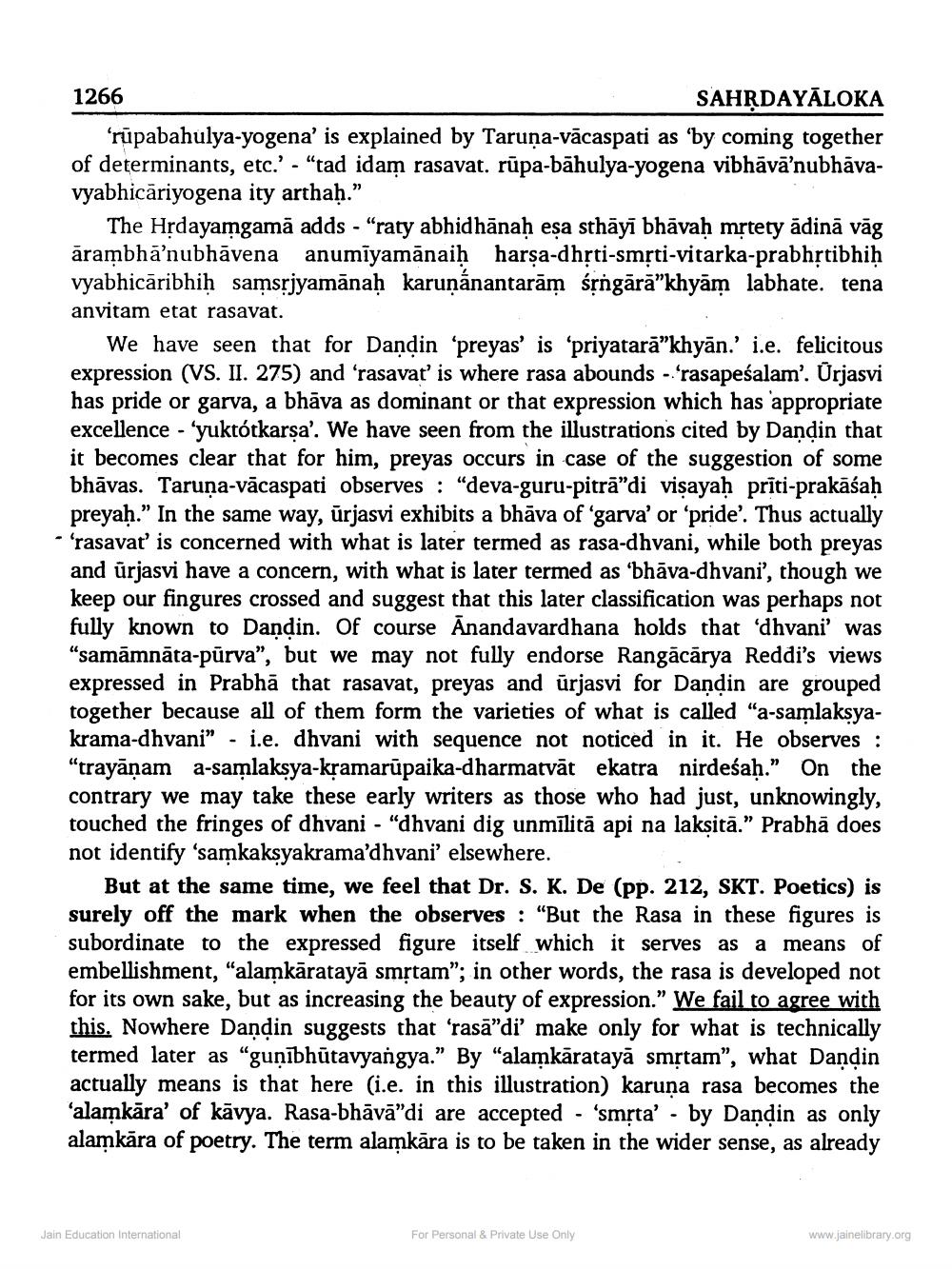________________
1266
SAHRDAYĀLOKA
rūpabahulya-yogena' is explained by Taruņa-vācaspati as 'by coming together of determinants, etc.' . "tad idam rasavat. rūpa-bāhulya-yogena vibhāvā'nubhāvavyabhicăriyogena ity arthah."
The HỊdayamgamā adds - “rary abhidhānaḥ eșa sthāyī bhāvah mộtety ādinā vāg ārambhā'nubhāvena anumīyamānaiḥ harsa-dhști-smrti-vitarka-prabhṛtibhih vyabhicāribhiḥ samsrjyamānaḥ karuņánantarām śrngārā”khyām labhate. tena anvitam etat rasavat.
We have seen that for Dandin 'preyas' is 'priyatarā”khyān.' i.e. felicitous expression (VS. II. 275) and 'rasavat' is where rasa abounds - 'rasapeśalam'. Urjasvi nas pride or garva, a bhāva as dominant or that expression which has appropriate excellence - 'yukrótkarsa'. We have seen from the illustrations cited by Dandin that it becomes clear that for him, preyas occurs in case of the suggestion of some bhāvas. Taruna-vācaspati observes : "deva-guru-pitrā”di visayaḥ priti-prakāśaḥ preyah.” In the same way, ūrjasvi exhibits a bhāva of 'garva' or 'pride'. Thus actually ‘rasavat' is concerned with what is later termed as rasa-dhvani, while both preyas
irjasvi have a concern, with what is later termed as 'bhāva-dhvani', though we keep our fingures crossed and suggest that this later classification was perhaps not fully known to Dandin. Of course Anandavardhana holds that 'dhvani' was "samāmnāta-pūrva", but we may not fully endorse Rangācārya Reddi's views expressed in Prabhā that rasavat, preyas and urjasvi for Dandin are grouped together because all of them form the varieties of what is called "a-samlaksyakrama-dhvani" - i.e. dhvani with sequence not noticed in it. He observes :
yānam a-samlaksya-kramarūpaika-dharmatvāt ekatra nirdeśah.” On the contrary we may take these early writers as those who had just, unknowingly, touched the fringes of dhvani - "dhvani dig unmīlitā api na laksitā." Prabhā does not identify ‘samkaksyakrama'dhvani' elsewhere.
But at the same time, we feel that Dr. S. K. De (pp. 212, SKT. Poetics) is surely off the mark when the observes : "But the Rasa in these figures is subordinate to the expressed figure itself which it serves as a means of embellishment, "alamkāratayā smộtam"; in other words, the rasa is developed not for its own sake, but as increasing the beauty of expression." We fail to agree with this. Nowhere Dandin suggests that “rasā"di' make only for what is technically termed later as "guņībhūtavyangya." By "alamkāratayā smộtam”, what Dandin actually means is that here (i.e. in this illustration) karuna rasa becomes the 'alamkāra' of kāvya. Rasa-bhāvā"di are accepted - 'smta' - by Dandin as only alamkāra of poetry. The term alamkāra is to be taken in the wider sense, as already
Jain Education International
For Personal & Private Use Only
www.jainelibrary.org




